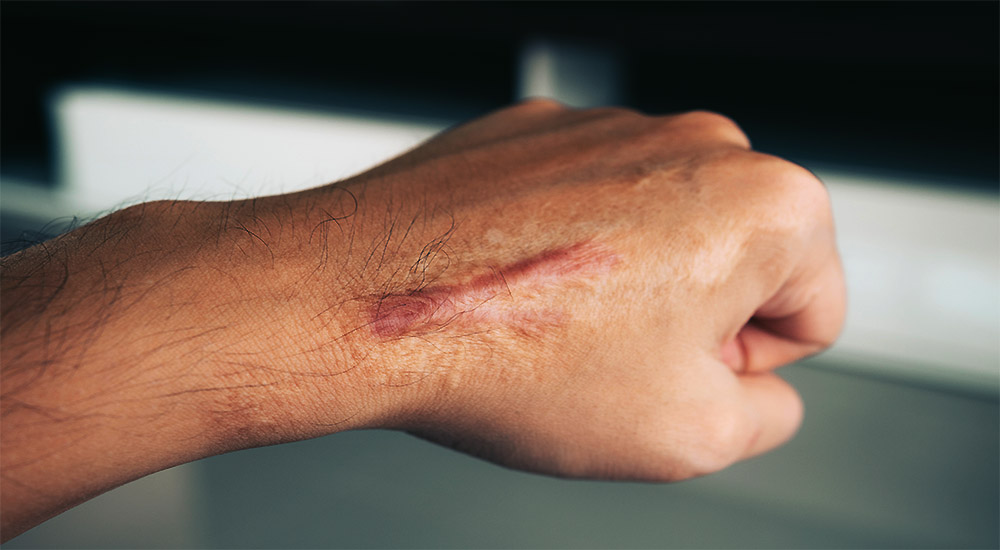Physical Therapy Helps Scar Tissue

Untreated Scar Tissue Can Become a Problem
If you cut yourself, have surgery, or tear tissue in the body, scar tissue will develop. The development of scar tissue is part of the normal healing process in the body, but it can also pose problems if it develops to excess or improperly. This is where Physical Therapy can be of great help.
After an injury to a muscle, tendon, skin, or ligaments, the inflammatory process within the body starts to heal the injury site. This process helps to ensure that the injured site is cleaned up from old debris and new cells are brought to the site that will soon become healthy tissue. Some of these new cells are called “collagen cells”.
Collagen is a substance that is present in all body parts. It is present in skin, bones, muscles, tendons, and ligaments. The consistency of collagen makes it inherently a very strong substance and it can resist forces, such as stretching and pulling, without tearing or breaking. It is the loss of collagen in the skin that allows wrinkles to form.
Unfortunately, the body does not know exactly how to arrange the collagen cells after an injury or surgery. Often the cells become a balled-up clump of tissue called “scar tissue”. But the good news is that this clumpy scar tissue is not permanent. It can be changed to look like normal healthy tissue again. The process, which does this, is called “remodeling”.
Scars Don’t Have To Be Permanent
Many people feel that scar tissue is a permanent or negative thing, but it doesn’t have to be. Scar tissue is part of the normal healing process in the body, but scar tissue that has not been properly remodeled can become a problem. For example, if you have surgery for knee replacement, a surgical scar will be present in the front of the knee.
This scar can become adhered to the underlying tissue and prevent a normal range of motion from occurring. Definitely not a good outcome. That is why it is important to speak to a physical therapist if you are injured or have had surgery. I have seen many instances, unfortunately, where the surgeon has paid very little attention to the way the scar tissue heals. And they often may not refer those patients with scar tissue to get any remodeling done.
The unfortunate outcome is that the patient remains unaware of the potential problem associated with the scar tissue while also feeling that he/she has to live with an ugly, lumpy scar for the rest of his/her life. This simply is not true.
Getting Treatment Is Very Important
Why should scar tissue be remodeled?
1. It can help decrease pain
2. It can improve range of motion in the surrounding joint and muscle
3. It restores normal mobility and function
I usually see two types of patients who ultimately require scar tissue remodeling:
1) The first type is the individual who already knows about scar tissue and is aware of the concept of remodeling.
The patients who fall into this category are typically those who have had plastic surgery or have a poorly healed scar post-surgery. With these patients, I perform a very detailed assessment discovering the nature of the surgery or injury, the type of scar tissue that has developed, and the quality of the healing that has occurred.
Some scars are newly healing and require an approach that is different from a scar that is chronic in nature. The length of the scar and its position is also very important. After the assessment, I begin treatment with various massage techniques. I also use friction tools that precisely help to break up mangled scar tissue.
I further advise patients on how to do certain massage techniques on themselves. This home care is extremely important because scar tissue mobilization must be done every day. If the scar tissue lays over a joint or multiple joints, then stretching exercises for that body part is also critical. The persistent stretching will help in the scar tissue remodeling also.
2) The second type of patient is one who may have come to me with a different structural issue and during their examination, I stumble upon scar tissue in the area of the problem. The patient may or may not be aware of a potential problem with the scar. I then proceed with educating them about the problem and how we can correct it. Then we treat not only the structural issue which the patient originally came in but also the scar tissue, which is a win-win situation for the patient.
Techniques Used by Physical Therapists Work
Scar tissue can be remodeled by various techniques. Each of these techniques is unique and has a different purpose and must be tailored to the individual patient. Some of those commonly used are “myofascial release” and “cross friction massage”. There are certain principles that are common to all the techniques.
mobilization – this has to be done along the length of the tissue
lubrication – a must when mobilizing scar tissue
electrical modalities – depending on the age of the scar these can be helpful
cold, heat, and therapeutic ultrasound
All these can make the scar tissue softer and more pliable.
The message I’d like to impart is to not neglect any kind of scar. Whether it’s after heart surgery, stomach surgery, knee, hip surgery, from a fracture, burns, or some other injury, talk to a physical therapist and get the scar treated correctly. You’ll be very glad that you did. I hope you found this informative.
Do you need help with your health?
We have the diagnostic and testing tools, the clinical experience, and a different medical approach to discovering the root cause of why you have the symptoms that are bothering you. As long as you are ready to make some dietary and lifestyle changes, we can help you. We will "hold your hand" through the changes, step by step, to make each step an easy one. We are located in Clearwater, FL, at 1000 S Ft Harrison, at the corner of Ft. Harrison Ave. and Magnolia St. There is plenty of parking space directly accessible from Ft Harrison. If it is not convenient for you to come to Root Cause Medical Clinic, we offer telehealth/telemedicine consultations to residents of certain states. Call us for details.
Contact us for a Consultation – Call 727-335-0400
Ask a Doctor
Have a health concern you'd like to speak with a doctor about? Or just want clarity on a subject? Ask Us!
Featured Articles
Popular Stories

Dr. Rupa Chakravarty DPT, OCS
Director of Physical Therapy at Root Cause Medical
Doctor of Physical Therapy, Orthopedic Certified Specialist
Dr. Chakravarty has numerous certifications for different techniques in Physical Therapy practice. She employs an extensive array of manual as well as exercise techniques to manage her patients’ symptoms during their course of therapy.


